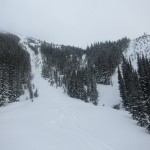Trip Date: January 15, 2012
Participants: Dave Robertson, Andrzej Jarzabek, Jamal Ahmelid, Giovanni Ghigliotti, Caroline Le Bouteiller, Ed Zenger, Geoff Zenger (organizer)
Difficulty: 2
Report: Despite the best efforts of the staff at Whistler Olympic Park (WOP) to frustrate our day, my second BCMC trip of the weekend ended up a great success. Originally we intended to meet at 8am sharp at the base of the ski jumps, but the WOP officials decided that this was not to be the case. Despite the gate being fully manned when we arrived at 7:45am, the woman inside informed us that we could not pass until 8:30 sharp, when the park officially opened. We (along with some other backcountry users not aware of this policy) patiently waited until 8:30, at which point we were directed to go to the main lodge to speak with a patroller, who would inform us on how we could access the backcountry. On speaking to her, we found out that we would have to pay $10 per person to park in their lot, and furthermore, that they had decided to close all access to the backcountry from the area around the ski jumps (from which the ascent route begins in Baldwin’s description), and that the only permitted access is now from the biathlon area, a km or so to the west. Nobody we talked to seemed to understand the lay of the backcountry around the park, and I think that it is fair to say that WOP is going out of their way to discourage backcountry users from crossing their territory.
We finally got started from the biathlon facility a bit past 9am, with the intention of heading up to Hanging Lake, and from there, to Gin Peak. On the far side of the biathlon track, there were two routes apparent to us: one, to the left, went by a box that read something like “backcountry access registration”, and the other, to the right, had no apparent sign other than one saying “ski area boundary”. If you ever find yourself in this place, do yourself a favour and take the route to the right (the actual Hanging Lake trail), not the one on the left, as we followed the tracks on the route to the left into the middle of nowhere, and then found ourselves contouring around the hill on icy slopes for nearly an hour until we managed to hit the proper Hanging Lake trail.
The Hanging Lake trail was well trodden, easy to follow, and we made quick time up to Hanging Lake. Of interest, we weren’t far up the trail from where we hit it, and around 1100m, encountered 3 guys hiking up the trail in snow boots, searching for their snowmobiles that they had abandoned above the knoll in the fog the previous night. It sounded as if they had intended to descend on snowmobile from Hanging Lake to WOP, although it’s hard to see how they thought this would be a good idea, especially given how little snow there is low down.
We had lunch at Hanging Lake shortly after noon, and from there it was a quick jaunt up over the ridge to the south east, where we encountered the snowmobile highway. Leading up from Rainbow Lake to the west side of Gin Peak was, in effect, a groomed path created by dozens of runs up and down by snowmobiles. There were at least 12 snowmobiles idling down on Rainbow Lake, and they occasionally darted up and down the slopes of Gin Peak as we ascended them. We all hit the summit of Gin Peak (my first summit of 2012!) at about 1:45 pm, and took some time to enjoy the views before heading down.
The powder on the first few hundred metres of the descent was fantastic, even for a while below Hanging Lake, and even once the powder ran out, the descent was quick and uneventful. We were back at the cars by 3:30, and an excellent day was had by all.
Verdict: 2/3. Not the most exciting peak, but has a very easy ascent, fun descent, good views, and safe in most avi conditions.
 For a few months at the end of last year, it was near impossible to walk by a book store without noticing a prominently placed copy of Thinking, Fast and Slow, and in short order curiosity got the better of me and I sat down to read this book. Written by Daniel Kahneman, the winner of the 2002 Nobel Prize in Economics, this is no fluffy Malcolm Gladwell book, but is instead a deep and wonderful book that reveals many remarkable insights into the human mind.
For a few months at the end of last year, it was near impossible to walk by a book store without noticing a prominently placed copy of Thinking, Fast and Slow, and in short order curiosity got the better of me and I sat down to read this book. Written by Daniel Kahneman, the winner of the 2002 Nobel Prize in Economics, this is no fluffy Malcolm Gladwell book, but is instead a deep and wonderful book that reveals many remarkable insights into the human mind.


































